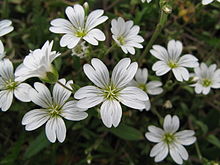Cerastium
| Cerastium | |
|---|---|

| |
| Cerastium arvense | |
| Scientific classification | |
| Kingdom: | |
| (unranked): | |
| (unranked): | |
| (unranked): | |
| Order: | |
| Family: | |
| Genus: | Cerastium |
| Species | |
|
About 200 - see text | |
Cerastium is a genus of annual, winter annual, or perennial plants belonging to the family Caryophyllaceae. They are commonly called mouse-ear chickweed. Species are found nearly worldwide but the greatest concentration is in the northern temperate regions. There are about 200 species.[1][2] A number are common weeds in fields and on disturbed ground.

Cerastium species are used as food plants by the larvae of some Lepidoptera species including Coleophora chalcogrammella (which feeds exclusively on Cerastium arvense) and Coleophora striatipennella (which has been recorded on Cerastium fontanum).
Cerastium Tomentosum (UK Snow In Summer) Great ground cover for those 'difficult' areas. Likes full sun and free draining soil though I have had great success in full shade and damp ground. One of the easiest plants to propagate. I just pull off a lump,with or without roots, dig a slit, poke it in, water well and it invariably roots rapidly and flowers the following year. Can be invasive.
Selected species
- Cerastium aleuticum – Aleutian chickweed
- Cerastium alpinum – alpine chickweed
- Cerastium arcticum – arctic mouse-ear chickweed
- Cerastium arvense – field chickweed
- Cerastium axillare – Trans-Pecos chickweed
- Cerastium beeringinanum – Bering chickweed
- Cerastium bialynickii
- Cerastium biebersteinii – boreal chickweed
- Cerastium brachypetalum – gray chickweed
- Cerastium brachypodum – shortstalk chickweed
- Cerastium cerastoides – mountain chickweed
- Cerastium dichotomum – forked chickweed
- Cerastium diffusum – fourstamen chickweed
- Cerastium dubium – doubtful chickweed
- Cerastium fischerianum – Fischer's chickweed
- Cerastium fontanum – common mouse-ear chickweed
- Cerastium furcatum – Korean mouse-ear chickweed[3]
- Cerastium glomeratum – sticky chickweed
- Cerastium gorodkovianum – tundra chickweed
- Cerastium gracile – slender chickweed
- Cerastium maximum – great chickweed
- Cerastium nigrescens – Shetland mouse-ear chickweed
- Cerastium nutans – nodding chickweed
- Cerastium pumilum – European chickweed
- Cerastium regelii – Regel's chickweed
- Cerastium semidecandrum – five-stamen chickweed
- Cerastium sordidum – Chihuahuan chickweed
- Cerastium terrae-novae – Newfoundland mouse-ear chickweed
- Cerastium texanum – Texas chickweed
- Cerastium tomentosum – snow in summer
- Cerastium utriense
References
- ^ Cerastium en PlantList
- ^ Cerastium. Flora of North America.
- ^ English Names for Korean Native Plants (PDF). Pocheon: Korea National Arboretum. 2015. p. 405. ISBN 978-89-97450-98-5. Retrieved 22 December 2016 – via Korea Forest Service.
External links
